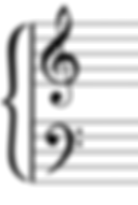


Reading Music on the Staff
A staff is a set of five lines which establish a graph on which to show pitch. Notes are markers on the graph which designate specific pitches.
The higher the note is on the staff, the higher the pitch. The lower a note is on the staff, the lower the pitch.
Notes can mark pitch by being placed on either a line or a space of the staff. A note that is placed in the space between the lines is called a 'space note.' A note that is placed on top of a line is called a 'line note.'
The lines and spaces of the staff represent pitches which are lettered. Only the letters A, B, C, D, E, F, G are used, which repeat. (There are no H's in music.)
The staff is labeled with clef signs to designate which pitches the lines and spaces represent.
A treble clef sign looks somewhat like a cursive G, and the curlique circles the G line. A treble clef sign always labels the second line of the staff as the G above Middle C.
A bass clef sign is somewhat similar to a cursive F, if you connect the dots. The two dots of the bass clef sign are placed on either side of the F line, labeling the second line down as the F directly below Middle C.
When these two staves are bracketed together, they form the Grand Staff. Different instruments use different staves according to the range of high and low pitches the instument is capable of reaching. For example, a flute uses only a treble clef staff, while piano uses the Grand Staff because it is capable of a giant range of high and low pitches.




G

F

higher
lower
line note
space note
high
low


staff
note
Read Music Method, the graph to staff approach, provides an unforgettably fun and easy way to teach and learn how to read music.
